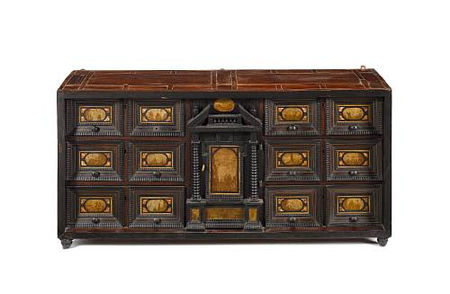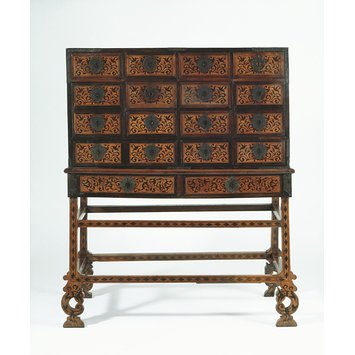The fall flap of this Spanish writing cabinet conceals carved drawers and very small cupboards. The tiny columns give an architectural feel and imitate spiral Baroque columns.
The cabinet sits on a stand with spirally carved and fluted supports.
Augsburg Cabinet
This cabinet is made from indigenous walnut, elm, maple, and fruitwood, and is decorated inside and out with intarsia, depicting architectural and floral motifs. c.1600

Italian Cabinet
The rectangular top and sides inlaid with ivory cartridges centred to the front by year architectural pediment flanked by Above a door turned columns, the interior fitted with drawers, to the sides flanked by six smaller drawers simulating long drawers, on tapering feet.
Monique Riccardo-Cubitt, The Art of the Cabinet. In the 1620's, the use of a type of stone with natural veining pietre paesina or 'landscape stone' was employed for decorative effect. When panels of it were mounted on cabinets the Albanese limestone which After being polished reveals a natural pattern of mountainous rocky outlines, or the Lineato Arno, a different Albanese variety of the limestone, featuring wavey seas and rivers suggesting patterns. Both kinds of stone provide a perfect background for painted landscapes, or when firms have mounted it on the table present lot.

Indo-Portuguese Cabinet-On-Stand
Inlaid with various woods - sixteen small drawers above two larger drawers, all with floral scrollwork in black on orange with blue metal floral scrollwork lockplates. Diamond lozenge decoration on runners and thin legs of stand, culminating in feet of a coiled serpent.
The form and decoration of this cabinet are typical of a large group of, now antique furniture, made in India under Portuguese patronage. Although pieces of this type were produced in quantity, there is very little that can be firmly established about the workshops which made them. Some idea of date of manufacture is provided by parallels with European furniture; large multiple-drawer cabinets without doors or a fall-front, and mounted on stands, were very much in fashion in the second half of the seventeenth century. High-style European furniture of that period is also characterised by intarsia of a variety of types, including ‘seaweed’ marquetry, named after the intricate interlacing designs and dense arabesques that were inlaid. Although these are possible influences, Indo-Portuguese cabinets of this type are also characterised by wholly distinctive elements such abstracted animal and geometric designs which have no precedent in any one European or Indian tradition. The scrolling legs, for instance, derive from seventeenth-century Iberian furniture, but are inlaid with bird forms that scholars have associated with jatayu, king of the vultures and a central character in the Ramayana. The materials, inlay and intricately pierced mounts on cabinets of this type bear an affinity with fitted chests of drawers and cabinets in the Sacristy of the Basilica of Bom Jesus, Old Goa. This was built in 1654 and it was likely that the cabinets were constructed shortly afterwards.

Flemish Cabinet
Panels depicting a variety of rural landscapes have been set into this ebony cabinet from Antwerp. The piece has a rectangular hinged top, and two doors at the front. The interior of this piece of handmade furniture has nine drawers around a columned door with a broken arch pediment, behind which is a mirrored interior.

No comments:
Post a Comment